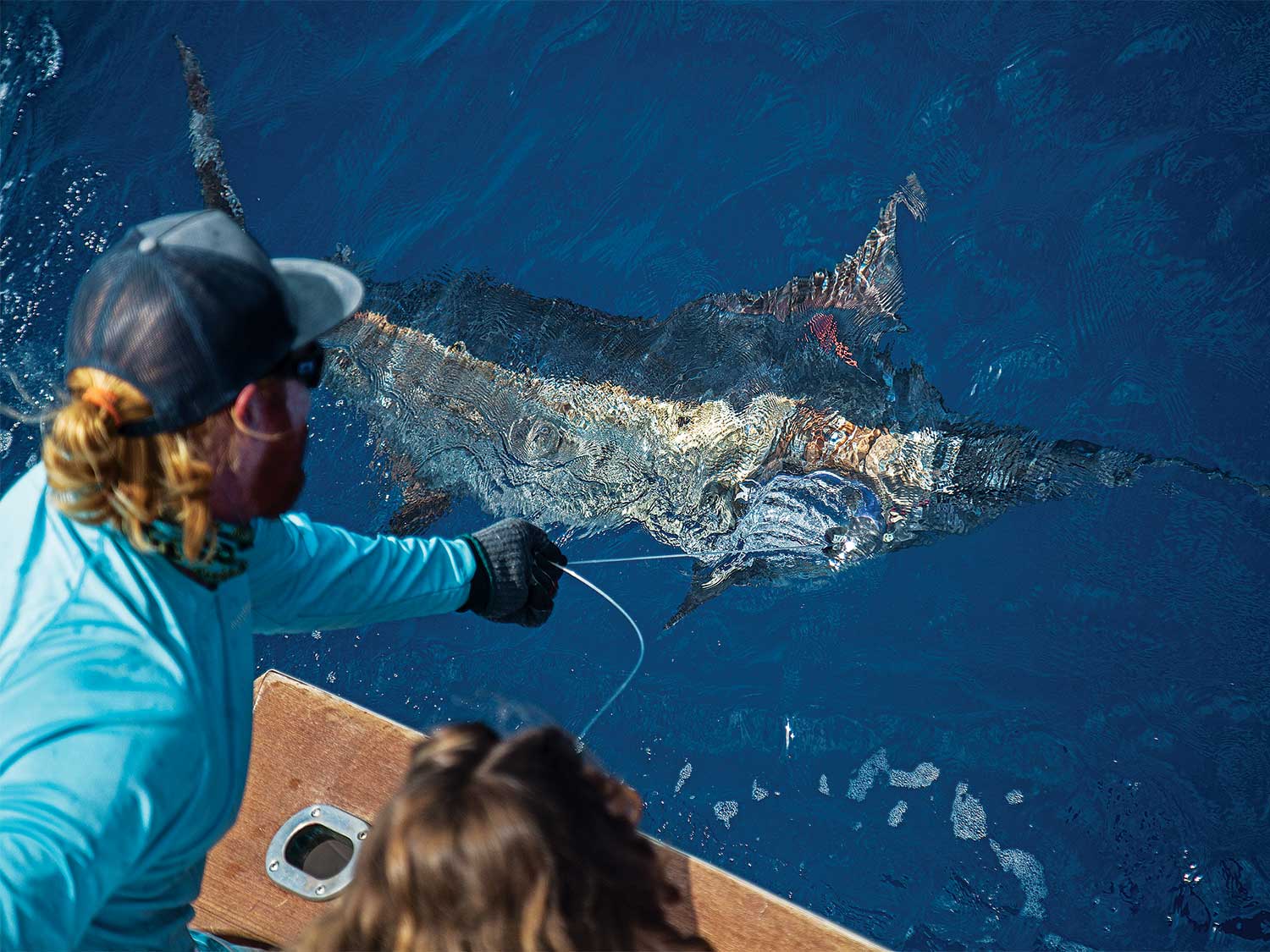Article Courtesy: marlinmag.com | Originally Published: 6/28/2022 | Click here for original article
Handling a Blue Marlin at the Boat
Your double line is coming up, or perhaps you can even see the fluorescent wind-on just below the surface. The anticipation of the release is palpable. The angler has done his job, and now the crew is ready for the endgame. But whether you’re releasing the fish or taking a lethal swing, at this point it’s almost a second thought and sitting on the back burner—there’s still a long way to go. Every fish is different, and every response to the boat is different as well.
As the crewman steps between the angler and the covering board, all eyes are on him. It’s imperative that he touch that leader. No matter how you explain this task, it’s quite possibly the most important job on the boat in this moment of time. But he cannot do it alone. The mental relationship that exists between the wireman and the captain is one of near silence; they are able to read each other like a book, so to say, and the banter occurring between them just moments ago now exists in a vacuum.
The Approach
As the fish gets closer to the boat, the captain, crew and angler need to be ready for anything. An otherwise docile fight could get messy when the fish gets on the wire or abruptly changes direction. And depending on where it’s hooked, that could also determine its attitude, especially once someone starts yanking on its face (or eyeball socket or protruding stomach).
It’s important to always keep your wits about you as you are getting ready to put your hand on the leader. Constantly communicating with your angler is one way to ensure that he is doing everything in his power to make the process quick and streamlined. Angler awareness is the most important message here because his job does not end when the swivel reaches the rod tip. Having an unnoticed tip wrap or a length of stray leader lying on the deck or swinging in the wind is just asking for trouble. The angler is responsible for not only finishing his task, but also making sure he is doing everything he can to keep the wireman—and himself—safe.
The captain must also be aware of what’s happening in the cockpit. Just because you can’t hear him, doesn’t mean he can’t hear you—so the boat driver needs to be sure that he is paying attention as well. Having the boat moving at the same speed as the fish keeps the captain ready to anticipate the next move; the boat is always easier to maneuver from a rolling start rather than from a dead stop. Even on the wire, marlin can be notoriously spooky and exhibit great bursts of energy, so staying with the fish ensures that you know exactly where it is and what it’s up to.
The wireman also needs to be prepared for what might happen. Sunglasses, ball cap and shoes stay on; gloves are wet and on; and the release knife or cutters are on his body to cut the fish—or himself—loose when the time is right.

Once your fish is under control boatside, remove the hook-set, place a tag, or take a picture—but do it fast, and learn to recognize changes in fish behavior to avoid any problems. Richard Gibson
Got ’Em
Less is always more when handling your fish boatside. Once your fish is on the wire, lead him away from the transom. Never start wiring a fish from the center of the transom (that’s the worst possible position to be in if you go overboard), and unless you want to hear it from the captain (who hears it from the owner when the yard bill comes due), you need to get the fish on the side to either place a tag, retrieve your lure, cut the leader, remove the hook, or sink the gaff.
Always start from the aft corner and lead the fish to the side it’s swimming toward. Keeping the head in the water and on a short leash will make the whole process safer for the mate, as well as for the folks in the cockpit. With the fish’s head nearly immobilized and submerged just under the surface, the fish will usually stay calm and behave long enough for you to expeditiously finish your release or even take pictures, but as the old adage goes, if you give them an inch, they’ll take a mile. Take too much time boatside, and you will either have to start the fighting process all over again as 100 yards of line comes flying off the reel or watch your fish jump off into the sunset. If you get lucky and the marlin is still attached, it’s a good idea to let him fight off this energy first. And sometimes, a wild, green fish will require you to cut him off quickly and say goodbye to your hook-set—but hey, that’s fishing.
Safety is the First Priority
While nothing is cooler than battling a blue marlin of any size on the wire, you must know that the longer it stays on a lead, the more likely it is to get agitated. If you divert your attention elsewhere, even for a second or two, and try to pull the fish in the boat or pull the bill up for a picture, you are inviting problems.
Reconsider bringing a green fish boatside too soon because sometimes they are just too rowdy to safely deal with, especially for a less-experienced crew. Even professionals make mistakes, so if you want to stay in the boat, try to think one step ahead, just as the captain is thinking one step ahead of the wireman and the fish.
If you keep a watchful eye on the fish, you’re more likely going to know when circumstances are getting ready to change. Just a simple head shake or even a forceful tail wag could have you begging for the cutters if the single hook comes at you before you can duck out of the way—or worse, the double-hook rig flies into your hand, pinning you to the fish. If you notice the fish change its behavior—lighting up or changing colors, or flipping its dorsal fin up and down—you might want to start wrapping up your release. Unpredictability is what keeps us coming back for more, but wrangling with wild animals also comes with some element of risk.
So, whether you touch the leader, grab it or wrap it, you still must deal with it. Staying alert, anticipating and recognizing that things can go downhill, and being prepared to tackle whatever situation might come your way is the responsibility of everyone on board. And the backup plan? Well, it is always a good idea to have one.






